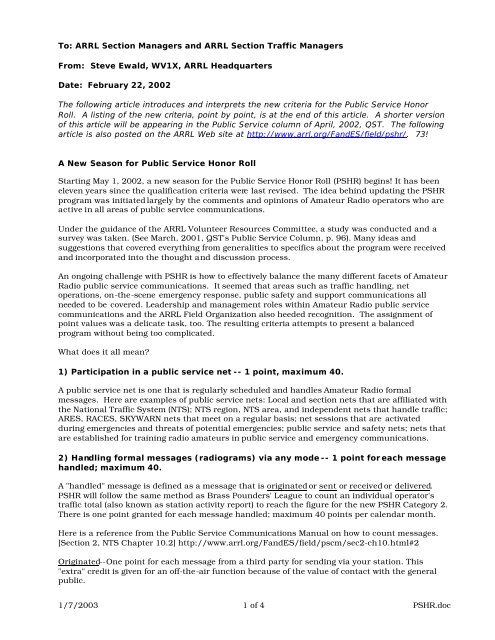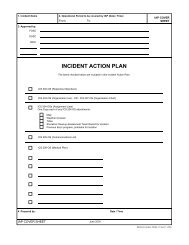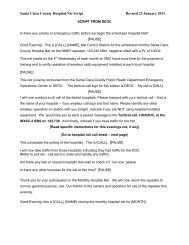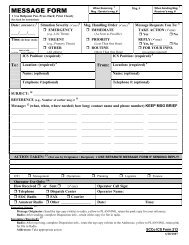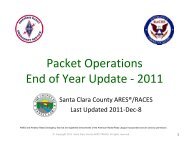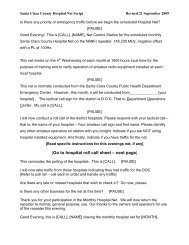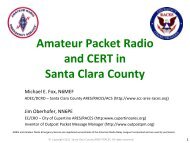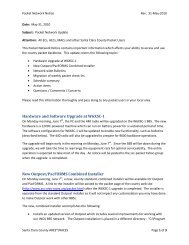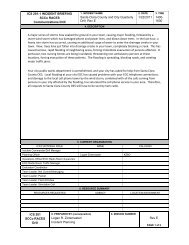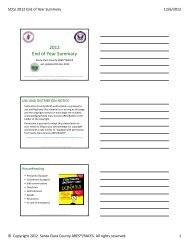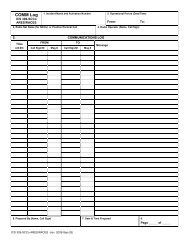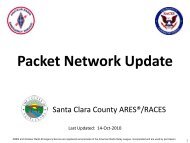(PSHR) Criteria
(PSHR) Criteria
(PSHR) Criteria
Create successful ePaper yourself
Turn your PDF publications into a flip-book with our unique Google optimized e-Paper software.
To: ARRL Section Managers and ARRL Section Traffic Managers<br />
From: Steve Ewald, WV1X, ARRL Headquarters<br />
Date: February 22, 2002<br />
The following article introduces and interprets the new criteria for the Public Service Honor<br />
Roll. A listing of the new criteria, point by point, is at the end of this article. A shorter version<br />
of this article will be appearing in the Public Service column of April, 2002, QST. The following<br />
article is also posted on the ARRL Web site at http://www.arrl.org/FandES/field/pshr/. 73!<br />
A New Season for Public Service Honor Roll<br />
Starting May 1, 2002, a new season for the Public Service Honor Roll (<strong>PSHR</strong>) begins! It has been<br />
eleven years since the qualification criteria were last revised. The idea behind updating the <strong>PSHR</strong><br />
program was initiated largely by the comments and opinions of Amateur Radio operators who are<br />
active in all areas of public service communications.<br />
Under the guidance of the ARRL Volunteer Resources Committee, a study was conducted and a<br />
survey was taken. (See March, 2001, QST's Public Service Column, p. 96). Many ideas and<br />
suggestions that covered everything from generalities to specifics about the program were received<br />
and incorporated into the thought and discussion process.<br />
An ongoing challenge with <strong>PSHR</strong> is how to effectively balance the many different facets of Amateur<br />
Radio public service communications. It seemed that areas such as traffic handling, net<br />
operations, on-the-scene emergency response, public safety and support communications all<br />
needed to be covered. Leadership and management roles within Amateur Radio public service<br />
communications and the ARRL Field Organization also heeded recognition. The assignment of<br />
point values was a delicate task, too. The resulting criteria attempts to present a balanced<br />
program without being too complicated.<br />
What does it all mean?<br />
1) Participation in a public service net -- 1 point, maximum 40.<br />
A public service net is one that is regularly scheduled and handles Amateur Radio formal<br />
messages. Here are examples of public service nets: Local and section nets that are affiliated with<br />
the National Traffic System (NTS); NTS region, NTS area, and independent nets that handle traffic;<br />
ARES, RACES, SKYWARN nets that meet on a regular basis; net sessions that are activated<br />
during emergencies and threats of potential emergencies; public service and safety nets; nets that<br />
are established for training radio amateurs in public service and emergency communications.<br />
2) Handling formal messages (radiograms) via any mode -- 1 point for each message<br />
handled; maximum 40.<br />
A "handled" message is defined as a message that is originated or sent or received or delivered.<br />
<strong>PSHR</strong> will follow the same method as Brass Pounders' League to count an individual operator's<br />
traffic total (also known as station activity report) to reach the figure for the new <strong>PSHR</strong> Category 2.<br />
There is one point granted for each message handled; maximum 40 points per calendar month.<br />
Here is a reference from the Public Service Communications Manual on how to count messages.<br />
[Section 2, NTS Chapter 10.2] http://www.arrl.org/FandES/field/pscm/sec2-ch10.html#2<br />
Originated--One point for each message from a third party for sending via your station. This<br />
"extra" credit is given for an off-the-air function because of the value of contact with the general<br />
public.<br />
1/7/2003 1 of 4 <strong>PSHR</strong>.doc
Sent--Every message sent over the air from your station to another amateur receives a point in<br />
this category. Thus, a message that is eligible for an Originated point as above receives another<br />
point when it is sent on the air.<br />
Likewise, a message that is received on the air conveys a Sent point when it is relayed to another<br />
station. A message that you initiate yourself, while it gets no Originated point, gets a Sent point<br />
when cleared. All Sent points require on-the-air sending.<br />
Received--A message received over the air gets a Received point, whether received for relaying<br />
(sending) or for delivery to the addressee. Any message received which is not eligible for a Delivery<br />
point (such as one addressed to yourself) is nevertheless eligible for a Received point.<br />
Delivered--The act of delivery of a message to a third party receives a point in this category, in<br />
addition to a Received point. This is strictly an off-the-air function and must be coupled with<br />
receipt of the message at your station. Thus you can't get a Delivered point unless you first get a<br />
Received point.<br />
Further example for clarification: If I send a message originated on behalf of myself, I know I get<br />
only one point for a message SENT. However, if I originate a message on behalf of a third party,<br />
and then send it, I get TWO points, (origination and sending), even though ONE message was<br />
handled.<br />
3) Serving in an ARRL-sponsored volunteer position: ARRL Field Organization<br />
appointee or Section Manager, NTS Net Manager, TCC Director, TCC member, NTS<br />
official or appointee above the Section level. -- 10 points for each position;<br />
maximum 30.<br />
ARRL Field Organization appointees (in alphabetical order) include the following: Assistant Section<br />
Managers, District Emergency Coordinators, Emergency Coordinators, Local Government<br />
Liaisons, Net Managers, Official Bulletin Stations, Official Emergency Stations, Official Observers,<br />
Official Observer Coordinators, Official Relay Stations, Public Information Coordinators, Public<br />
Information Officers, Section Emergency Coordinators, Section Managers, Section Traffic<br />
Managers, State Government Liaisons, Technical Specialists.<br />
The Section Manager is the ARRL-member elected League official the section. NTS Net Managers<br />
would include the following nets: NTS Region and NTS Area. TCC (Transcontinental Corps)<br />
Director is in charge of organizing his/her TCC membership roster of operators that comprise the<br />
corps. TCC members are those operators that are assigned to relay traffic from one NTS area to<br />
another, conducting liaison with NTS nets to do so. NTS official or appointee above the Section<br />
level includes NTS Area Staff Chairs, NTS Area Digital Coordinators and NTS Digital Stations.<br />
More information about the structure of the NTS and the positions and nets that are mentioned in<br />
this article may be found in the ARRL's Public Service Communications Manual. It is ARRLWeb at<br />
http://www.arrl.org/FandES/field/pscm/<br />
4) Participation in scheduled, short-term public service events such as walk-a-thons,<br />
bike-a-thons, parades, simulated emergency tests and related practice events. This<br />
includes off-the-air meetings and coordination efforts with related emergency groups<br />
and served agencies. -- 5 points per hour (or any portion thereof) of time spent in<br />
either coordinating and/or operating in the public service event; no limit.<br />
This category recognizes the value of public safety communication events that Amateur Radio is<br />
often called to participate in. Simulated emergency tests, exercises, and drills are covered by this<br />
category. Points are gained by the amount of time that an Amateur Radio operator spends directly<br />
involved in operating the event. This also recognizes the value of off-the-air time it takes to meet<br />
with the organization or public service agency to plan and coordinate Amateur Radio involvement.<br />
1/7/2003 2 of 4 <strong>PSHR</strong>.doc
5) Participation in an unplanned emergency response when the Amateur Radio<br />
operator is on the scene. This also includes unplanned incident requests by public or<br />
served agencies for Amateur Radio participation. -- 5 points per hour (or any portion<br />
thereof) of time spent directly involved in the emergency operation; no limit.<br />
This category recognizes an Amateur Radio operator who is directly involved in an actual<br />
emergency operation. This includes the operator who is on the scene or out in the field, in the<br />
shelter, at the emergency operations center, at the hospital, or other served agency's headquarters<br />
or their temporary command center.<br />
The second sentence of Category 5 invites the Amateur Radio operator who is an active participant<br />
in an unplanned incident -- or in other words, an emergency operation-- to take credit for his/her<br />
participation even though he/she is not physically at the e mergency scene.<br />
The intent behind Category 5 is to also include the Amateur Radio operators -- like net controllers,<br />
net operation and other radio amateurs that support communications in unplanned incidents--<br />
that are not actually on the emergency scene or at the shelter, etc, but are spending time and<br />
efforts for supporting the same emergency communication efforts.<br />
As an example, if the National Weather Service activates SKYWARN, Amateur Radio operators<br />
serve as weather spotters from their home (or car, or work, or other locations) during the weather<br />
event. Then, a tornado strikes and the Red Cross calls out the ARES members to serve in shelters<br />
and to provide support for damage assessment communications. These operators would be among<br />
those to qualify for points under Category 5.<br />
There would likely be several net control operators, net liaison operators, traffic handlers, etc, who<br />
are away from the disaster scene, but are spending time to support the Amateur Radio emergency<br />
communication effort on behalf of the served agencies (Red Cross and National Weather Service,<br />
in this example). They, too, would qualify for points under Category 5.<br />
6.) Providing and maintaining<br />
a) an automated digital system that handles ARRL radiogram-formatted<br />
messages;<br />
b) a Web page e-mail list server oriented toward Amateur Radio public service<br />
-- 10 points per item.<br />
The portion, "a," is a carry-over from the previous <strong>PSHR</strong> criteria as this sub category recognizes<br />
the efforts it takes to provide and maintain an automated digital system (like a packet bulletin<br />
board or a PACTOR system) that handles ARRL radiogram-formatted messages.<br />
The portion "b," is a new item. Since the last time <strong>PSHR</strong> criteria were revised, newer technologies<br />
like Web pages and e-mail list servers have become popular and effective ways to communicate<br />
news and information to the community of radio amateurs that are involved in emergency and<br />
public service communication operations and preparedness.<br />
Starting May 1, 2002<br />
The new <strong>PSHR</strong> qualification criteria goes into effect on May 1, 2002. Therefore, the August, 2002,<br />
QST will be the first month to report the results under the new criteria. If an Amateur Radio<br />
operator is presently in the middle of his/her quest for qualifying for the <strong>PSHR</strong> certificate under<br />
the old criteria, those months will continue to count toward the certificate.<br />
If you qualify for <strong>PSHR</strong> during a given month, send your results to either your Section Traffic<br />
Manager or Section Manager. These leaders, in turn, will forward the <strong>PSHR</strong> qualifiers to ARRL<br />
Headquarters for notation in the monthly <strong>PSHR</strong> listing in QST. Further questions about the<br />
program may be sent to Steve Ewald, WV1X, at ARRL Headquarters (sewald@arrl.org).<br />
1/7/2003 3 of 4 <strong>PSHR</strong>.doc
Public Service Honor Roll <strong>Criteria</strong> Effective May 1, 2002 (Summary)<br />
This li sting is to recognize radio amateurs whose public service performance during the month<br />
indicted qualifies for 70 or more total points in the following 6 categories (as reported to their<br />
Section Managers). Please note the maximum points for each category:<br />
1.) Participating in a public service net, using any mode.<br />
-- 1 point per net session; maximum 40.<br />
2.) Handling formal messages (radiograms) via any mode.<br />
-- 1 point for each message handled; maximum 40.<br />
3.) Serving in an ARRL-sponsored volunteer position: ARRL Field Organization appointee or<br />
Section Manager, NTS Net Manager, TCC Director, TCC member, NTS official or appointee above<br />
the Section level.<br />
-- 10 points for each position; maximum 30.<br />
4.) Participation in scheduled, short-term public service events such as walk-a-thons, bikea-thons,<br />
parades, simulated emergency tests and related practice events. This includes offthe-air<br />
meetings and coordination efforts with related emergency groups and served agencies.<br />
-- 5 points per hour (or any portion thereof) of time spent in either<br />
coordinating and/or operating in the public service event; no limit.<br />
5.) Participation in an unplanned emergency response when the Amateur Radio operator is<br />
on the scene. This also includes unplanned incident requests by public or served agencies for<br />
Amateur Radio participation.<br />
-- 5 points per hour (or any portion thereof) of time spent directly<br />
involved in the emergency operation; no limit.<br />
6.) Providing and maintaining:<br />
a) an automated digital system that handles ARRL radiogram-formatted messages;<br />
b) a Web page e-mail list server oriented toward Amateur Radio public service<br />
-- 10 points per item.<br />
Amateur Radio stations that qualify for <strong>PSHR</strong> 12 consecutive months, or 18 out of a 24 month<br />
period, will be awarded a certificate from Headquarters upon written notification of qualifying<br />
months to the Public Service Branch of Field and Educational Services at ARRL HQ.<br />
1/7/2003 4 of 4 <strong>PSHR</strong>.doc


